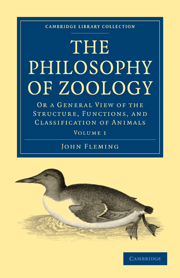 The Philosophy of Zoology
The Philosophy of Zoology Book contents
- Frontmatter
- Preface
- Contents
- Divisions of Natural Science
- CHAP. I Division of Natural Objects into Organised and Inorganic. The Chain of Being
- CHAP. II Peculiar Characters of Organised Bodies
- CHAP. III Distinguishing Characters of Animals and Vegetables
- CHAP. IV On the Polity of Nature
- CHAP. V On the Substances which enter into the Composition of the Bodies of Animals
- CHAP. VI Cutaneous System
- CHAP. VII Osseous System
- CHAP. VIII Muscular System
- CHAP. IX Nervous System
- CHAP. X Organs of Perception
- CHAP. XI Faculties of the Mind
- CHAP. XII Digestive System
- CHAP. XIII Circulating System
- CHAP. XIV Peculiar Secretions
- CHAP. XV Reproductive System
CHAP. I - Division of Natural Objects into Organised and Inorganic. The Chain of Being
Published online by Cambridge University Press: 29 August 2010
- Frontmatter
- Preface
- Contents
- Divisions of Natural Science
- CHAP. I Division of Natural Objects into Organised and Inorganic. The Chain of Being
- CHAP. II Peculiar Characters of Organised Bodies
- CHAP. III Distinguishing Characters of Animals and Vegetables
- CHAP. IV On the Polity of Nature
- CHAP. V On the Substances which enter into the Composition of the Bodies of Animals
- CHAP. VI Cutaneous System
- CHAP. VII Osseous System
- CHAP. VIII Muscular System
- CHAP. IX Nervous System
- CHAP. X Organs of Perception
- CHAP. XI Faculties of the Mind
- CHAP. XII Digestive System
- CHAP. XIII Circulating System
- CHAP. XIV Peculiar Secretions
- CHAP. XV Reproductive System
Summary
The objects which present themselves to the notice of the Natural Historian, on the surface of this globe, exhibit innumerable varieties of form, structure, action and position. But, however diversified in appearance, they readily admit of distribution into various groups, each including numerous species, capable of farther arrangement into subordinate tribes. The most extensive pf these groups, are two in number,–the one called the Organized,–the other the Inorganic Kingdom. The limits which separate these two divisions, are so well defined, that the distinction has been universally received.
Philosophers and poets, in all ages, have been anxious to point out a certain gradation of perfection in earthly objects,–a CHAIN OF BEING, the links of which consist of all created beings, passing by insensible degrees from the simplest to the most complicated, and constituting one harmonious whole, unbroken and dependent. Crystallization, they say, is the highest link of the inanimate part of the chain, and connects the Mineral with the Vegetable Kingdom. The lichen which encrusts the stone, is but one step higher in the scale of being than the stone itself. The mushrooms and corals, form a bond of union between the Vegetable and Animal Kingdoms; and the vast interval by which Man is separated from his Maker, is occupied by different orders of superior intelligences.
- Type
- Chapter
- Information
- The Philosophy of ZoologyOr a General View of the Structure, Functions, and Classification of Animals, pp. 3 - 6Publisher: Cambridge University PressPrint publication year: 2009First published in: 1822


